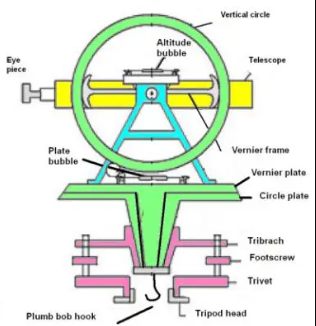Temporary and Permanent Adjustments of a Theodolite in Surveying
Introduction:
In the field of surveying, theodolites are essential instruments used for measuring horizontal and vertical angles accurately. To ensure precise measurements, the theodolite requires both temporary and permanent adjustments. Temporary adjustments are made every time the instrument is set up, while permanent adjustments focus on the fundamental lines and their relationships and should be performed periodically to maintain the instrument's accuracy.Temporary Adjustments:
1. Setting up:
- Place the tripod over the designated station.- Spread the tripod legs to form an angle of approximately 60° with the horizontal.
- Ensure the shoes of the tripod legs face the same direction.
- Securely attach the theodolite to the tripod at eye level for the surveyor.
- Use a plumb bob to assist in centering the instrument over the station mark.
2. Centering:
- Centering is crucial to position the vertical axis precisely over the station mark.
- Approximate centering can be achieved by adjusting the tripod legs radially or circumferentially.
- Radial leg adjustments cause the plumb bob to shift in the direction of the leg movement without significantly affecting the leveling.
- Sideways or circumferential leg adjustments have a more substantial impact on leveling.
- Verify approximate leveling using the circular bubble on the tribrach.
3. Levelling:
- Achieve accurate leveling using leveling screws or foot screws in reference to the plate level.- The goal is to make the vertical axis truly vertical or the horizontal plate truly horizontal.
- Ensure the axis of the plate bubble becomes horizontal, indicating accurate leveling.
4. Focusing the Eyepiece:
- Focus the eyepiece to make the crosshairs sharp and distinct.- Point the telescope toward the sky or a white sheet of paper.
- Gradually rotate the eyepiece in or out until the crosshairs appear sharp and clear.
- Eyepiece focus may vary based on the surveyor's eyesight, and it can be noted down for future reference.
5. Focusing the Objective:
- Focus the objective to bring the image of the object onto the plane of the crosshairs.- Direct the telescope toward the object of interest.
- Adjust the focusing screw until the object's image appears clear and sharp.
- Proper focusing eliminates parallax, ensuring that the image remains stationary relative to the crosshairs during observer eye movements.
Permanent Adjustments:
1. Adjustment of Plate Level:
- The first permanent adjustment involves aligning the axis of the plate bubble perpendicular to the vertical axis when the bubble is centered.2. Adjustment of Line of Sight:
- Ensure that the line of sight coincides with the optical axis of the telescope.- When the line of sight is horizontal, it is referred to as a line of collimation.
- A vertical plane is generated when the horizontal axis is perpendicular to the vertical axis.
3. Adjustment of Horizontal Axis:
- Perform the spire test to verify that the horizontal axis is perpendicular to the vertical axis.4. Adjustment of Altitude Level:
- Ensure that the altitude level is correctly adjusted to maintain accuracy in vertical angle measurements.Conclusion:
In the field of surveying, theodolites play a pivotal role in measuring horizontal and vertical angles accurately. To maintain their precision, temporary adjustments are performed each time the instrument is set up, while permanent adjustments focus on fundamental lines and their relationships, ensuring the instrument remains properly calibrated over time. These adjustments collectively contribute to the reliability and accuracy of theodolite measurements in civil engineering and surveying applications. #civilengineerfriend








No comments:
Post a Comment
If you are getting more information from civilengineerfriend page please give your comments. Share the page information in your whatsapp group. Subscribe our page to get more information.